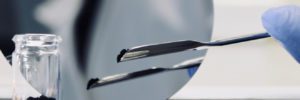
Researchers at the Karlsruhe Institute of Technology (KIT) and Jilin University have investigated a promising anode material for future high-performance batteries: lithium lanthanum titanate with a perovskite crystal structure (LLTO). As the team reported in Nature Communications, LLTO can improve battery energy density, power density, charging rate, safety and cycle life without requiring a particle size decrease from micro to nano scale.
Anodes of lithium-ion batteries consist of a current collector and an active material—usually graphite—that stores energy in the form of chemical bonds. However, negative electrodes made of graphite have a low charging rate, and are associated with safety issues. Among the alternatives, lithium titanate oxide (LTO) has already been commercialized. Negative electrodes with LTO present a higher charging rate and are considered to be safer than those made of graphite, but they tend to have a lower energy density.

According to the study, which was led by Professor Helmut Ehrenberg, LLTO anodes have a lower electrode potential compared to commercialized LTO anodes, which allows for a higher cell voltage and a higher capacity. “Cell voltage and storage capacity ultimately determine the energy density of a battery,” explains Ehrenberg. “In the future, LLTO anodes might be used to build particularly safe high-performance cells with long cycle life.”
To improve the charging rate, it is common practice to reduce the particle size of the electrode material from micro to nano scale. The study shows that even particles of a few micrometers in size in LLTOs with a perovskite structure feature a higher power density and a better charging rate than LTO nanoparticles. “Thanks to the larger particles, LLTO basically enables simpler and more cost-effective electrode manufacturing processes,” says Ehrenberg.
Source: KIT
Photo: Julia Maibach, KIT
source https://chargedevs.com/newswire/new-anode-material-could-lead-to-safer-batteries-with-long-cycle-life/
No comments:
Post a Comment